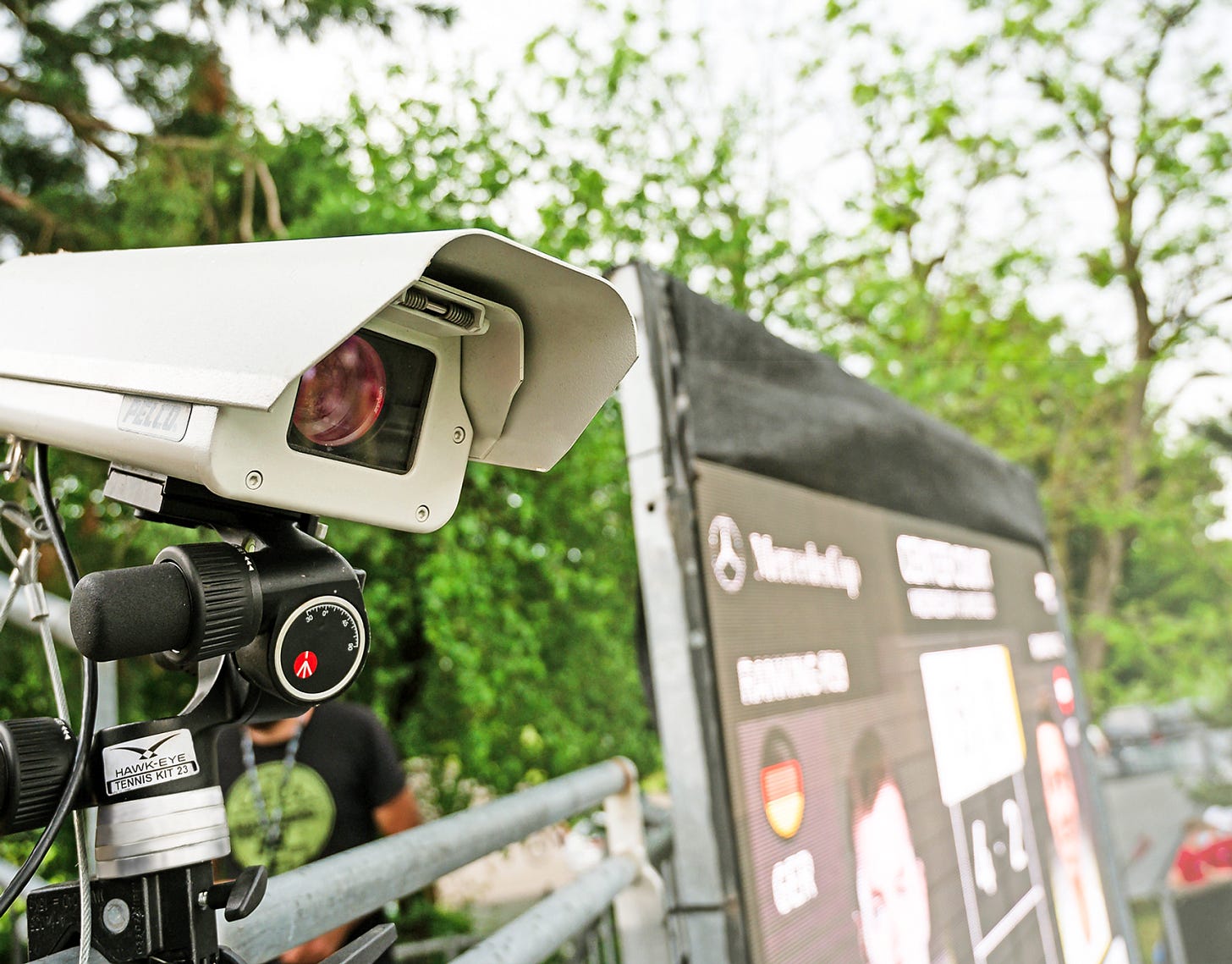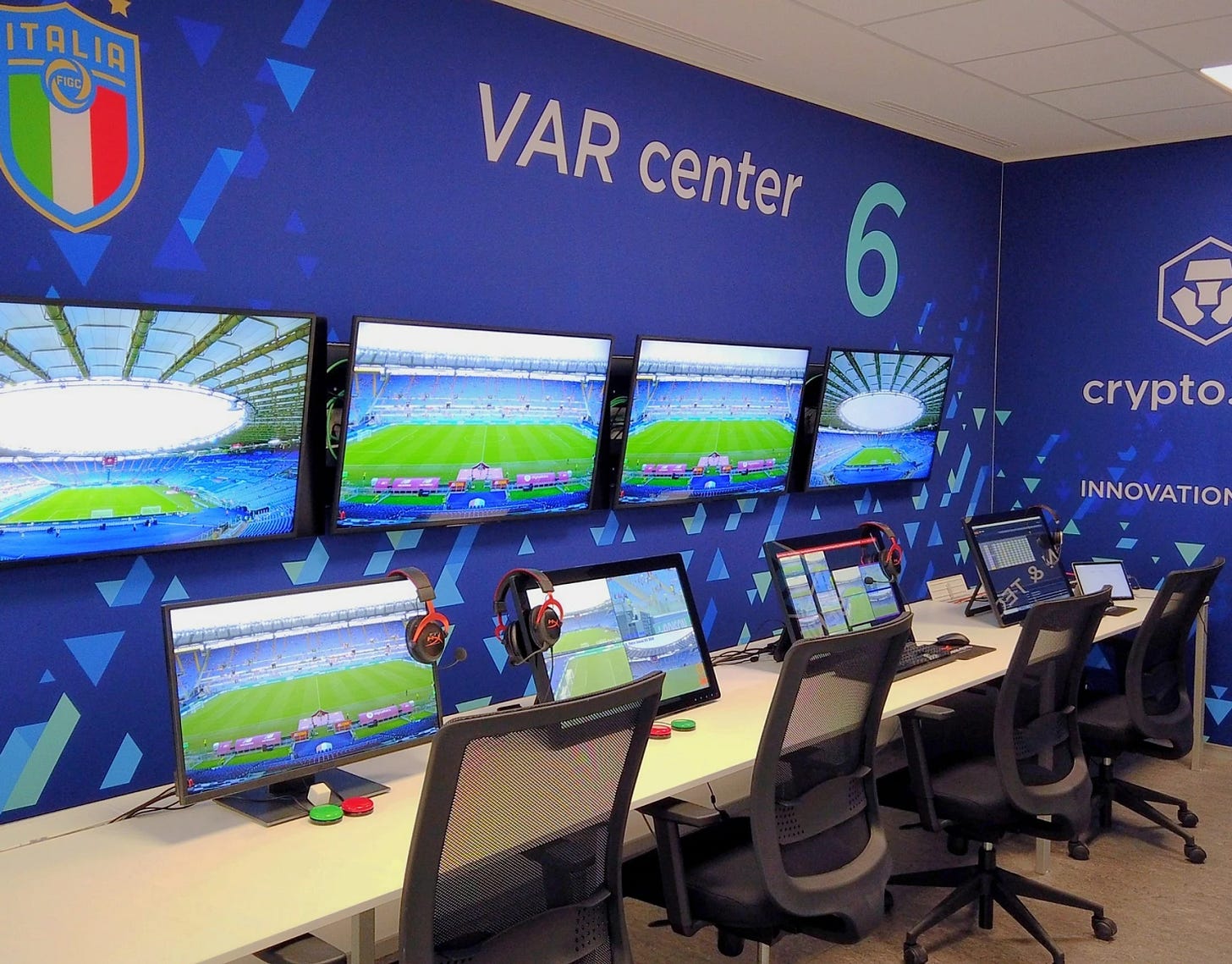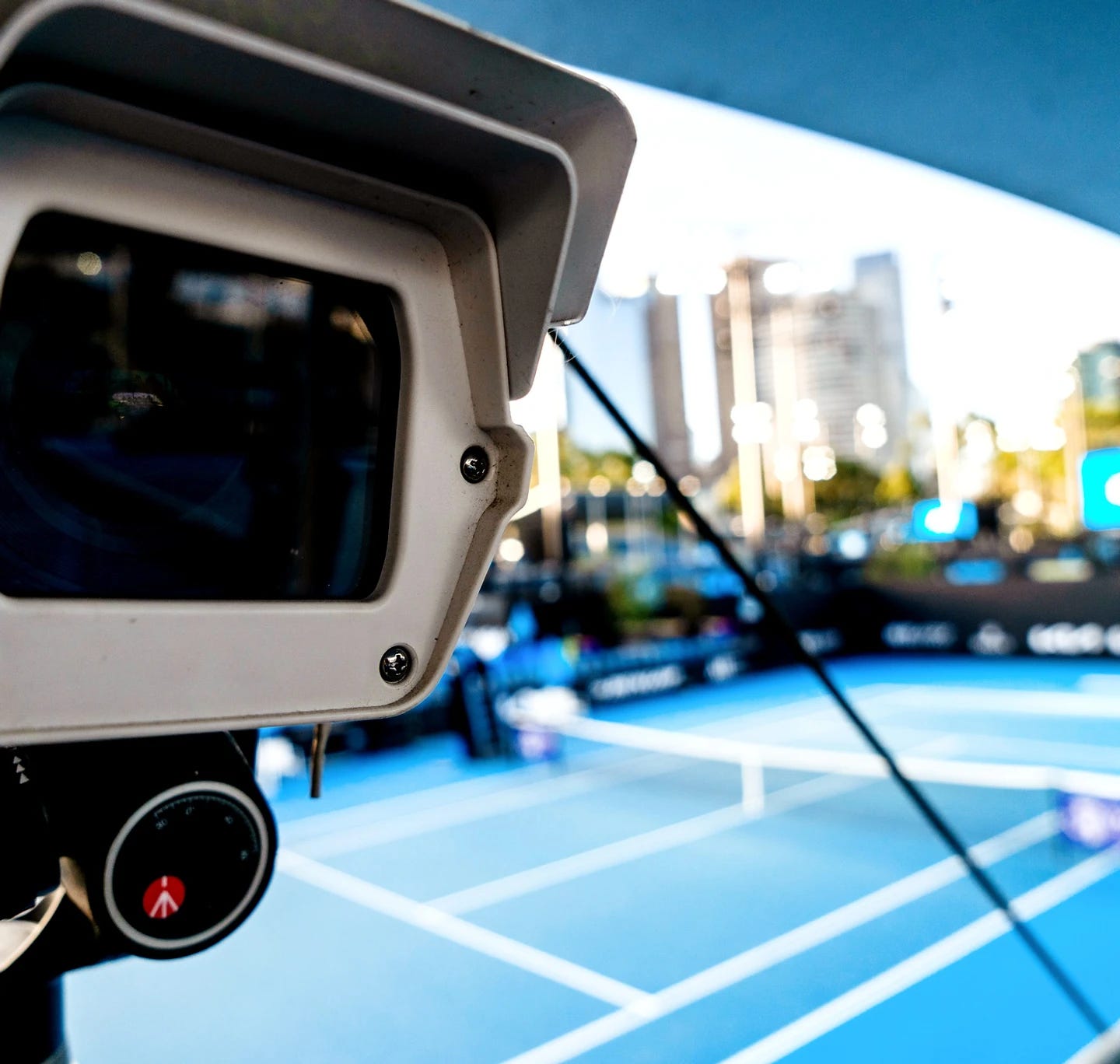Hawk-Eye's Watchful Gaze: Revolutionising Major Sports
From tennis to football, discover how this cutting-edge technology is changing the game and redefining fairness in sports.
Image source: Hawk-Eye Innovations
The First Whistle
In the high-stakes world of professional sports, where milliseconds and millimeters can mean the difference between victory and defeat, the need for precision has never been greater. Enter Hawk-Eye, a groundbreaking innovation that has transformed the landscape of sports officiating. As part of our ongoing series exploring cutting-edge technology at major tournaments currently underway, this newsletter delves into the fascinating world of Hawk-Eye technology. We'll explore its impact across various sports and its role in ensuring fairness and accuracy. From grand slam tennis matches to crucial football games, we'll uncover how this electronic line-calling system is revolutionising the way we experience and officiate sports.
The Human Dilemma: Why Hawk-Eye Was Born
For decades, the sports world grappled with a fundamental challenge: the limitations of human perception in officiating, making split-second decisions that could alter the course of a game. As athletes pushed the boundaries of speed and skill, it became increasingly clear that even the most experienced officials could struggle to keep pace.
The need for Hawk-Eye arose from several key issues:
Speed of Play: In sports like tennis, where serves can exceed 150 mph, it's nearly impossible for the human eye to track the ball accurately.
Optical Illusions: The angle of view can often deceive even the most experienced officials, leading to incorrect calls.
Consistency: Human judgment can vary from official to official and even from moment to moment, leading to inconsistencies in decision-making.
High Stakes: With millions of dollars and prestigious titles on the line, the margin for error in professional sports has become increasingly small.
Fan Engagement: Controversial calls often led to fan dissatisfaction and heated debates, potentially damaging the integrity of the sport.
These challenges set the stage for a technological solution that could provide unbiased, accurate, and instant decisions - paving the way for Hawk-Eye Innovations to transform sports officiating.
Hawk-Eye 101: The Basics
Hawk-Eye is a sophisticated computer system used in sports to visually track the trajectory of the ball and display a record of its statistically most likely path as a moving image. Developed by Hawk-Eye Innovations, this technology has revolutionised sports officiating and analysis.
The Hawk-Eye system is divided into three main components:
Synchronised Multi-Angle Replay Technology (SMART): This component captures high-speed video footage from multiple angles around the playing area. Each camera can capture up to 340 frames per second, providing incredibly detailed visual data.
TRACK: This system processes the captured video data to track the performance of players, the ball, or other objects of interest. It uses specialised image-processing techniques to identify and follow the center of the ball within each frame.
INSIGHT: This component collects and analyses the data generated by the TRACK system. It calculates the ball's location in three-dimensional space to an accuracy of 3.6 mm and can provide this information to officials within seconds of the play occurring.
Here's how the overall system works:
Multiple high-speed video cameras are placed around the playing area, each capturing up to 340 frames per second.
The video feeds are triangulated and combined to create a 3D representation of the ball's path.
Specialised image-processing techniques are used to identify the center of the ball within each frame.
The system calculates the ball's location in three-dimensional space to an accuracy of 3.6 mm.
The results are available to officials within seconds of the play occurring.
Hawk-Eye is now widely used in 23 of the top 25 leagues and federations globally, such as:
Tennis: For line calls and player challenges
Cricket: For LBW (Leg Before Wicket) decisions
Football: As part of goal-line technology
Volleyball: For line calls and challenges
Badminton: For line calls and challenges
By providing an objective, technology-driven solution, Hawk-Eye has significantly reduced human error in officiating, enhancing fairness and reducing controversies in major sports events worldwide.
Image source: Hawk-eye Innovations
Spotlight: Hawkeye at Current Tournaments
Hawk-Eye technology is making its presence felt across several major sporting events this year, enhancing officiating and viewer experience:
COPA America 2024: Currently underway, this prestigious soccer tournament is utilising Hawk-Eye's VAR and Semi-Automated Offside (SAO) systems to ensure accurate decision-making in crucial moments.
UEFA Euro 2024: The European football championship is benefiting from Hawk-Eye's full suite of soccer technologies, including VAR, SAO, and Goal Line Technology (GLT).
Paris Olympics 2024: Hawk-Eye will be prominently featured in the volleyball events, aiding with line calls and providing detailed analytics on player performance.
US Open 2024: Later this year, tennis fans will see Hawk-Eye in action for line calls and player challenges, continuing its longstanding presence in Grand Slam events.
T20 Cricket World Cup: The recently concluded tournament showcased Hawk-Eye's capabilities in cricket, particularly for the Decision Review System (DRS) and ball tracking for LBW decisions.
Behind the Scenes: The Technical Setup
The implementation of Hawk-Eye varies across sports, but always involves a sophisticated array of cameras and processing systems:
Tennis:
10 to 18 high-speed cameras are strategically placed around the court.
These cameras capture up to 340 frames per second for ultra-precise ball tracking.
Soccer:
As the creator of VAR, Semi-Automated Offside (SAO), and Goal Line Technology (GLT), Hawk-Eye's setup in soccer is particularly comprehensive.
Multiple cameras cover the entire field, with specialised cameras focused on goal lines for GLT.
For SAO, additional cameras track player positions in real-time.
Cricket:
Hawk-Eye is integral to the Decision Review System (DRS).
Multiple cameras are used for ball tracking, especially crucial for LBW (Leg Before Wicket) analysis.
The system can recreate the ball's trajectory to determine if it would have hit the stumps.
Volleyball:
Similar to tennis, 10 cameras are placed around the court.
These cameras are used for line calls and replays.
The system also tracks player reaction times and the speed of serves and spikes, providing valuable insights for teams and broadcasters.
In all these sports, as well as in Major League Baseball (MLB) and the National Football League (NFL), the camera feeds are processed by powerful computers that can provide results within seconds. This rapid response time is crucial for maintaining the flow of the game while ensuring accurate decisions. In the MLB, Hawk-Eye is used for ball and strike calls, while in the NFL, it aids in reviewing plays and determining precise ball placement. The system's ability to quickly process complex visual data across such a diverse range of sports underscores its versatility and efficiency in enhancing officiating across the sporting world.
The versatility of Hawk-Eye across different sports showcases its adaptability and the continuous innovation driving its development. As these major tournaments unfold, Hawk-Eye will play a pivotal role in shaping fair outcomes and enhancing the viewer experience. This constant evolution of the technology naturally leads us to consider: what's next for Hawk-Eye?
Image source: Hawk-eye Innovations
The Future of Hawkeye: Basketball's New Frontier
In a significant development, Hawk-Eye technology made its debut in the NBA during the 2023-24 season, marking a new era in basketball officiating and analytics. This expansion into one of the world's most popular indoor sports demonstrates Hawk-Eye's potential for continued growth and adaptation.
Key features of the NBA's Hawk-Eye implementation include:
Advanced Camera Setup: 14 cameras are strategically placed in standardised locations around arenas. This is a significant upgrade from the previous system, which used only 6 cameras in arena rafters.
Enhanced Player Tracking: The new system tracks 29 points on players' bodies (arms, legs, hands, etc.) plus the ball in full 3D and near-real time. This replaces the old "dot" system, which created just a single point for each player at any given moment.
Improved Decision Making: The NBA is pairing Hawk-Eye with existing technologies to generate supplemental evidence for referees, particularly for goaltending decisions. The NBA Replay Center has already been outfitted with Hawk-Eye data feeds to support this initiative.
Future Expansions: The league is also testing on-the-line and last-touched out-of-bounds systems, which are expected to roll out in the following season.
This implementation in the NBA represents a quantum leap in sports technology application. By providing detailed 3D tracking of players and the ball, Hawk-Eye is not only assisting with officiating but also opening up new possibilities for performance analysis, strategic planning, and fan engagement.
The success of Hawk-Eye in basketball could pave the way for its adoption in other indoor sports, potentially revolutionising how these games are officiated, analysed, and experienced by fans. As Hawk-Eye continues to evolve and expand its capabilities, we can expect to see even more innovative applications across the sporting world, further blurring the line between human judgment and technological precision.
The Final Whistle
While Hawk-Eye technology has undoubtedly helped make sports fairer and more precise, it's worth noting that the debate isn't over. Traditionalists still argue in favour of human officiating, believing that the human element is an integral part of sports and should not be replaced by technology. This ongoing discussion between innovation and tradition continues to shape the future of sports.
Stay tuned to see how this fascinating interplay between cutting-edge technology and time-honoured sporting traditions develops. Don't miss out on our upcoming deep dives into other groundbreaking sports technologies, play-by-play. Want more sports tech insights? Share this newsletter and subscribe for weekly updates!






